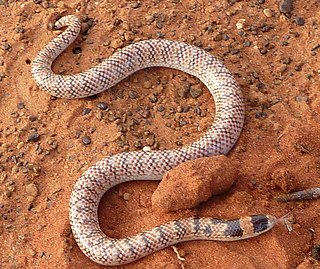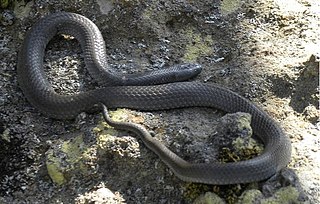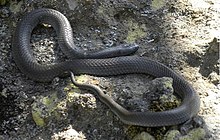
Cryptoblepharus is a genus of skinks, lizards in the family Scincidae. The genus contains at least 53 species.

Albert Karl Ludwig Gotthilf GüntherFRS, also Albert Charles Lewis Gotthilf Günther, was a German-born British zoologist, ichthyologist, and herpetologist. Günther is ranked the second-most productive reptile taxonomist with more than 340 reptile species described.

Children's python is a species of nonvenomous snake in the family Pythonidae. The species is named after John George Children. It is a nocturnal species occurring in the northern half of Australia and generally found on the ground, although it often climbs trees. Usually growing to about 1.0 m (3 ft) in length or more depending on the polymorphic variant, it is typically a reddish-brown colour, darker on the upper surface, and with many darker blotches, especially on younger specimens. The Stimson's python variant has much stronger and more variable colors; often being adorned with reddish-brown to chocolate blotches against lighter tan. It feeds mostly on small mammals and birds, and as with other pythons, it constricts its prey before swallowing it whole. It is a popular pet among reptile enthusiasts.

Stokes's sea snake is a large species of sea snake in the family Elapidae. It is sometimes placed in its own genus Astrotia. The species is endemic to tropical Indo-Pacific oceanic waters.

The spine-bellied sea snake, also commonly known as Hardwicke's sea snake and Hardwicke's spine-bellied sea snake, is a species of venomous sea snake in the family Elapidae.

Leptodeira is a genus of colubrid snakes commonly referred to as cat-eyed snakes. The genus consists of 18 species that are native to primarily Mexico and Central America, but range as far north as the Rio Grande Valley region of Texas in United States and as far south as Argentina in South America.

Pseudonaja is a genus of highly venomous elapid snakes native to Australia. Species of this genus are known commonly as brown snakes and are considered to be some of the most dangerous snakes in the world; even young snakes are capable of delivering a fatal envenomation to a human.
Drysdalia is a genus of snakes, commonly known as crowned snakes, belonging to the family Elapidae. The three species in this genus are venomous snakes, but not considered deadly.

Cacophis is a genus of venomous snakes, commonly known as crowned snakes, in the family Elapidae. The genus is endemic to Australia.

The white-lipped snake is a small species of venomous snake in the family Elapidae. The species is endemic to south-eastern mainland Australia and Tasmania.

Brachyurophis is a genus of elapid snakes known as shovel-nosed snakes, so named because of their shovel-nosed snout which is used to burrow. The genus has eight recognized species, which are all found in Australia.

Hilbrand Boschma was a Dutch zoologist and director of the Rijksmuseum of Natural History in Leiden.
This article lists the various snakes of Australia which live in a wide variety of habitats around the country. The amethystine python or scrub python is considered Australia's largest native snake.
Hemiaspis damelii is a species of venomous snake in the family Elapidae. It is a relatively small species of elapid with a mean snout-vent length (SVL) of 42.6 to 60 cm. The species is endemic to eastern Australia and is most commonly found across central inland New South Wales through to the interior of south-eastern Queensland. Common names for this species include grey snake and Dämel's Snake. The specific name, damelii, is in honor of German entomologist Edward Dämel, who collected Australian specimens for Museum Godeffroy.

Cryptophis nigrescens is a species of venomous snake in the family Elapidae. The species is endemic to eastern Australia.
Stegonotus is a genus of snakes in the family Colubridae. Species of the genus Stegonotus are native to Australia, Indonesia, and New Guinea.
Hydrablabes is a genus of snakes in the subfamily Natricinae of the family Colubridae. The genus contains two species.
The collared whipsnake is a medium-sized elapid endemic to Australia. It is found in rainforest edges and other tropical woodland areas as well as in rocky habitat and environments on offshore islands.
Cryptophis boschmai, also known commonly as the Carpentaria snake or the Carpentaria whip snake, is a species of venomous snake in the family Elapidae. The species is native to Australia and New Guinea.

Cryptophis pallidiceps, also known as the western Carpentaria snake or northern small-eyed snake, is a species of venomous snake endemic to Australia. The specific epithet pallidiceps (“pale-headed”) refers to its body markings.













